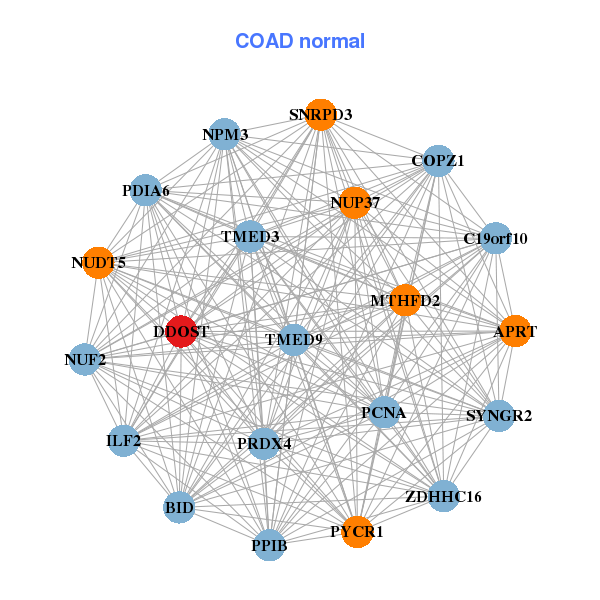|
||||||||||||||||||||
| |
| Phenotypic Information (metabolism pathway, cancer, disease, phenome) |
| |
| |
| Gene-Gene Network Information: Co-Expression Network, Interacting Genes & KEGG |
| |
|
| Gene Summary for DDOST |
| Basic gene info. | Gene symbol | DDOST |
| Gene name | dolichyl-diphosphooligosaccharide--protein glycosyltransferase subunit (non-catalytic) | |
| Synonyms | AGER1|CDG1R|OKSWcl45|OST|OST48|WBP1 | |
| Cytomap | UCSC genome browser: 1p36.1 | |
| Genomic location | chr1 :20978259-20988037 | |
| Type of gene | protein-coding | |
| RefGenes | NM_005216.4, | |
| Ensembl id | ENSG00000244038 | |
| Description | advanced glycation endproduct receptor 1dolichyl-diphosphooligosaccharide--protein glycosyltransferase 48 kDa subunitdolichyl-diphosphooligosaccharide-protein glycotransferaseoligosaccharyl transferase 48 kDa subunitoligosaccharyltransferase 48 kDa su | |
| Modification date | 20141219 | |
| dbXrefs | MIM : 602202 | |
| HGNC : HGNC | ||
| Ensembl : ENSG00000244038 | ||
| HPRD : 03728 | ||
| Vega : OTTHUMG00000002844 | ||
| Protein | UniProt: go to UniProt's Cross Reference DB Table | |
| Expression | CleanEX: HS_DDOST | |
| BioGPS: 1650 | ||
| Gene Expression Atlas: ENSG00000244038 | ||
| The Human Protein Atlas: ENSG00000244038 | ||
| Pathway | NCI Pathway Interaction Database: DDOST | |
| KEGG: DDOST | ||
| REACTOME: DDOST | ||
| ConsensusPathDB | ||
| Pathway Commons: DDOST | ||
| Metabolism | MetaCyc: DDOST | |
| HUMANCyc: DDOST | ||
| Regulation | Ensembl's Regulation: ENSG00000244038 | |
| miRBase: chr1 :20,978,259-20,988,037 | ||
| TargetScan: NM_005216 | ||
| cisRED: ENSG00000244038 | ||
| Context | iHOP: DDOST | |
| cancer metabolism search in PubMed: DDOST | ||
| UCL Cancer Institute: DDOST | ||
| Assigned class in ccmGDB | C | |
| Top |
| Phenotypic Information for DDOST(metabolism pathway, cancer, disease, phenome) |
| Cancer | CGAP: DDOST |
| Familial Cancer Database: DDOST | |
| * This gene is included in those cancer gene databases. |
|
|
|
|
|
| . | ||||||||||||||
Oncogene 1 | Significant driver gene in | |||||||||||||||||||
| cf) number; DB name 1 Oncogene; http://nar.oxfordjournals.org/content/35/suppl_1/D721.long, 2 Tumor Suppressor gene; https://bioinfo.uth.edu/TSGene/, 3 Cancer Gene Census; http://www.nature.com/nrc/journal/v4/n3/abs/nrc1299.html, 4 CancerGenes; http://nar.oxfordjournals.org/content/35/suppl_1/D721.long, 5 Network of Cancer Gene; http://ncg.kcl.ac.uk/index.php, 1Therapeutic Vulnerabilities in Cancer; http://cbio.mskcc.org/cancergenomics/statius/ |
| REACTOME_METABOLISM_OF_PROTEINS | |
| OMIM | |
| Orphanet | |
| Disease | KEGG Disease: DDOST |
| MedGen: DDOST (Human Medical Genetics with Condition) | |
| ClinVar: DDOST | |
| Phenotype | MGI: DDOST (International Mouse Phenotyping Consortium) |
| PhenomicDB: DDOST | |
| Mutations for DDOST |
| * Under tables are showing count per each tissue to give us broad intuition about tissue specific mutation patterns.You can go to the detailed page for each mutation database's web site. |
| - Statistics for Tissue and Mutation type | Top |
 |
| - For Inter-chromosomal Variations |
| * Inter-chromosomal variantions includes 'interchromosomal amplicon to amplicon', 'interchromosomal amplicon to non-amplified dna', 'interchromosomal insertion', 'Interchromosomal unknown type'. |
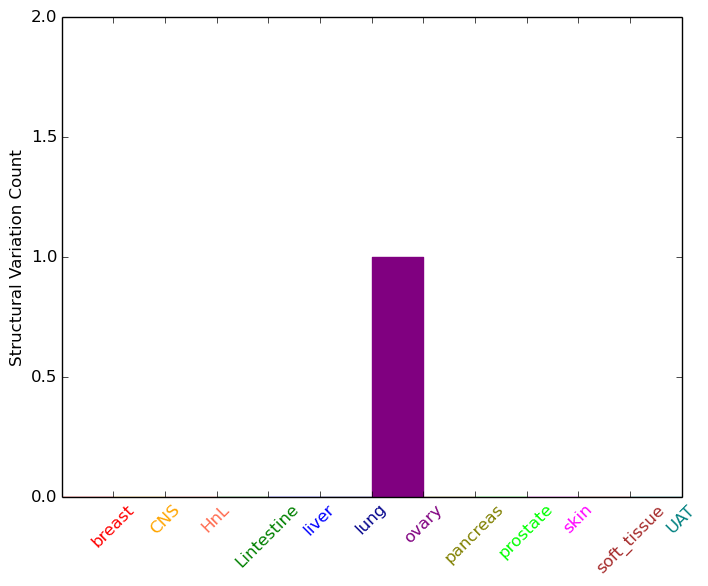 |
| - For Intra-chromosomal Variations |
| There's no intra-chromosomal structural variation. |
| Sample | Symbol_a | Chr_a | Start_a | End_a | Symbol_b | Chr_b | Start_b | End_b |
| ovary | DDOST | chr1 | 20984914 | 20985114 | chr4 | 106245716 | 106245916 |
| cf) Tissue number; Tissue name (1;Breast, 2;Central_nervous_system, 3;Haematopoietic_and_lymphoid_tissue, 4;Large_intestine, 5;Liver, 6;Lung, 7;Ovary, 8;Pancreas, 9;Prostate, 10;Skin, 11;Soft_tissue, 12;Upper_aerodigestive_tract) |
| * From mRNA Sanger sequences, Chitars2.0 arranged chimeric transcripts. This table shows DDOST related fusion information. |
| ID | Head Gene | Tail Gene | Accession | Gene_a | qStart_a | qEnd_a | Chromosome_a | tStart_a | tEnd_a | Gene_a | qStart_a | qEnd_a | Chromosome_a | tStart_a | tEnd_a |
| BF572086 | DDOST | 1 | 201 | 1 | 20978985 | 20979402 | ITPKC | 193 | 224 | 19 | 41227551 | 41227583 | |
| AW411410 | SOX6 | 461 | 510 | 11 | 16249441 | 16249490 | DDOST | 508 | 590 | 1 | 20978812 | 20978894 | |
| AW411241 | SOX6 | 479 | 528 | 11 | 16249441 | 16249490 | DDOST | 526 | 612 | 1 | 20978812 | 20978898 | |
| AW467499 | LYZ | 1 | 93 | 12 | 69747545 | 69747637 | DDOST | 83 | 380 | 1 | 20978613 | 20978909 | |
| AW614804 | OSTC | 1 | 312 | 4 | 109588663 | 109588974 | DDOST | 302 | 585 | 1 | 20978660 | 20978943 | |
| BF306134 | TMEM56 | 163 | 185 | 1 | 95639943 | 95639966 | DDOST | 180 | 677 | 1 | 20978617 | 20979214 | |
| Top |
| There's no copy number variation information in COSMIC data for this gene. |
| Top |
|
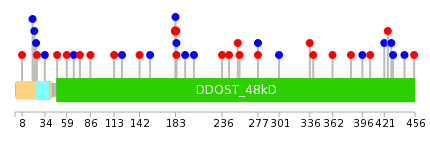 |
| Top |
| Stat. for Non-Synonymous SNVs (# total SNVs=20) | (# total SNVs=12) |
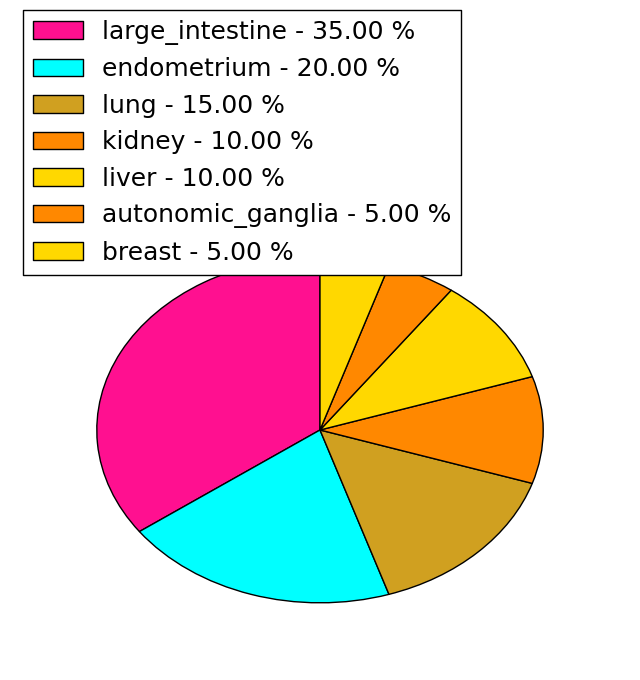 | 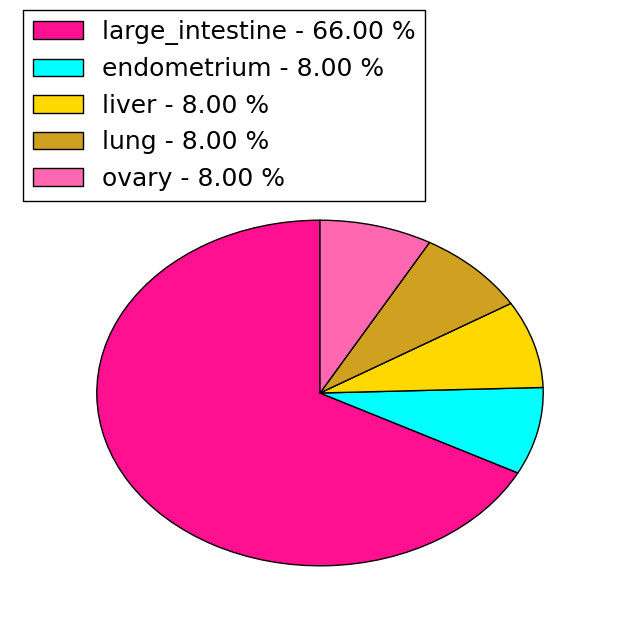 |
(# total SNVs=1) | (# total SNVs=0) |
 |
| Top |
| * When you move the cursor on each content, you can see more deailed mutation information on the Tooltip. Those are primary_site,primary_histology,mutation(aa),pubmedID. |
| GRCh37 position | Mutation(aa) | Unique sampleID count |
| chr1:20981988-20981988 | p.A183S | 2 |
| chr1:20981986-20981986 | p.A183A | 1 |
| chr1:20987752-20987752 | p.L48S | 1 |
| chr1:20978956-20978956 | p.Y429Y | 1 |
| chr1:20980730-20980730 | p.A277A | 1 |
| chr1:20987793-20987793 | p.L34L | 1 |
| chr1:20978970-20978970 | p.A425T | 1 |
| chr1:20980731-20980731 | p.A277V | 1 |
| chr1:20982214-20982214 | p.T154T | 1 |
| chr1:20987822-20987822 | p.R25W | 1 |
| Top |
|
 |
| Point Mutation/ Tissue ID | 1 | 2 | 3 | 4 | 5 | 6 | 7 | 8 | 9 | 10 | 11 | 12 | 13 | 14 | 15 | 16 | 17 | 18 | 19 | 20 |
| # sample | 9 | 1 | 2 | 1 | 2 | 4 | 3 | 4 | ||||||||||||
| # mutation | 10 | 1 | 2 | 1 | 2 | 4 | 3 | 4 | ||||||||||||
| nonsynonymous SNV | 4 | 1 | 1 | 1 | 2 | 3 | ||||||||||||||
| synonymous SNV | 6 | 1 | 2 | 2 | 3 | 1 |
| cf) Tissue ID; Tissue type (1; BLCA[Bladder Urothelial Carcinoma], 2; BRCA[Breast invasive carcinoma], 3; CESC[Cervical squamous cell carcinoma and endocervical adenocarcinoma], 4; COAD[Colon adenocarcinoma], 5; GBM[Glioblastoma multiforme], 6; Glioma Low Grade, 7; HNSC[Head and Neck squamous cell carcinoma], 8; KICH[Kidney Chromophobe], 9; KIRC[Kidney renal clear cell carcinoma], 10; KIRP[Kidney renal papillary cell carcinoma], 11; LAML[Acute Myeloid Leukemia], 12; LUAD[Lung adenocarcinoma], 13; LUSC[Lung squamous cell carcinoma], 14; OV[Ovarian serous cystadenocarcinoma ], 15; PAAD[Pancreatic adenocarcinoma], 16; PRAD[Prostate adenocarcinoma], 17; SKCM[Skin Cutaneous Melanoma], 18:STAD[Stomach adenocarcinoma], 19:THCA[Thyroid carcinoma], 20:UCEC[Uterine Corpus Endometrial Carcinoma]) |
| Top |
| * We represented just top 10 SNVs. When you move the cursor on each content, you can see more deailed mutation information on the Tooltip. Those are primary_site, primary_histology, mutation(aa), pubmedID. |
| Genomic Position | Mutation(aa) | Unique sampleID count |
| chr1:20980730 | p.A277A | 2 |
| chr1:20987829 | p.L74I | 1 |
| chr1:20979121 | p.D383N | 1 |
| chr1:20981983 | p.L34L | 1 |
| chr1:20987835 | p.L340I | 1 |
| chr1:20979188 | p.V336M | 1 |
| chr1:20981985 | p.L33L | 1 |
| chr1:20979440 | p.K301K | 1 |
| chr1:20981986 | p.A24A | 1 |
| chr1:20979452 | p.T22T | 1 |
| * Copy number data were extracted from TCGA using R package TCGA-Assembler. The URLs of all public data files on TCGA DCC data server were gathered on Jan-05-2015. Function ProcessCNAData in TCGA-Assembler package was used to obtain gene-level copy number value which is calculated as the average copy number of the genomic region of a gene. |
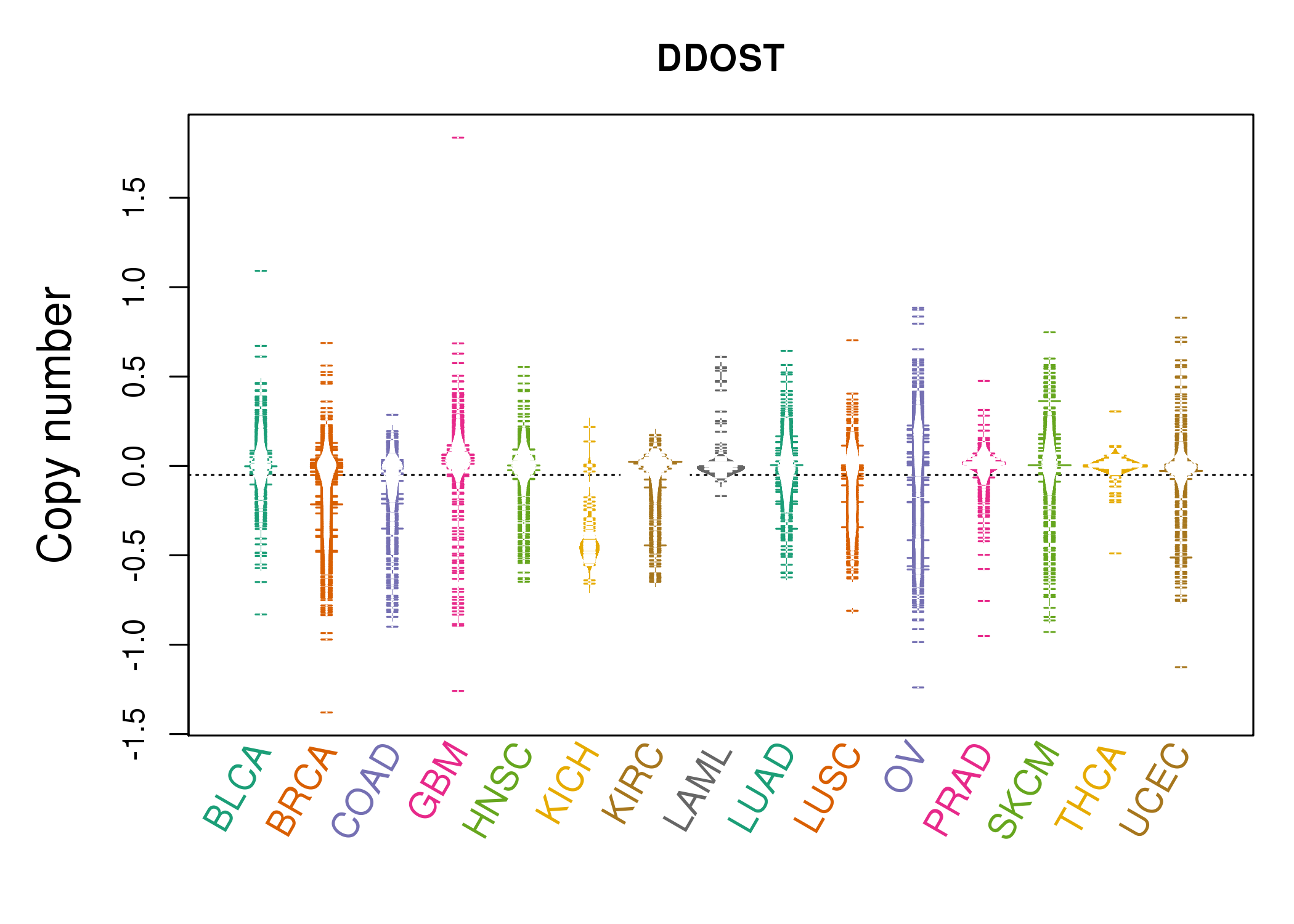 |
| cf) Tissue ID[Tissue type]: BLCA[Bladder Urothelial Carcinoma], BRCA[Breast invasive carcinoma], CESC[Cervical squamous cell carcinoma and endocervical adenocarcinoma], COAD[Colon adenocarcinoma], GBM[Glioblastoma multiforme], Glioma Low Grade, HNSC[Head and Neck squamous cell carcinoma], KICH[Kidney Chromophobe], KIRC[Kidney renal clear cell carcinoma], KIRP[Kidney renal papillary cell carcinoma], LAML[Acute Myeloid Leukemia], LUAD[Lung adenocarcinoma], LUSC[Lung squamous cell carcinoma], OV[Ovarian serous cystadenocarcinoma ], PAAD[Pancreatic adenocarcinoma], PRAD[Prostate adenocarcinoma], SKCM[Skin Cutaneous Melanoma], STAD[Stomach adenocarcinoma], THCA[Thyroid carcinoma], UCEC[Uterine Corpus Endometrial Carcinoma] |
| Top |
| Gene Expression for DDOST |
| * CCLE gene expression data were extracted from CCLE_Expression_Entrez_2012-10-18.res: Gene-centric RMA-normalized mRNA expression data. |
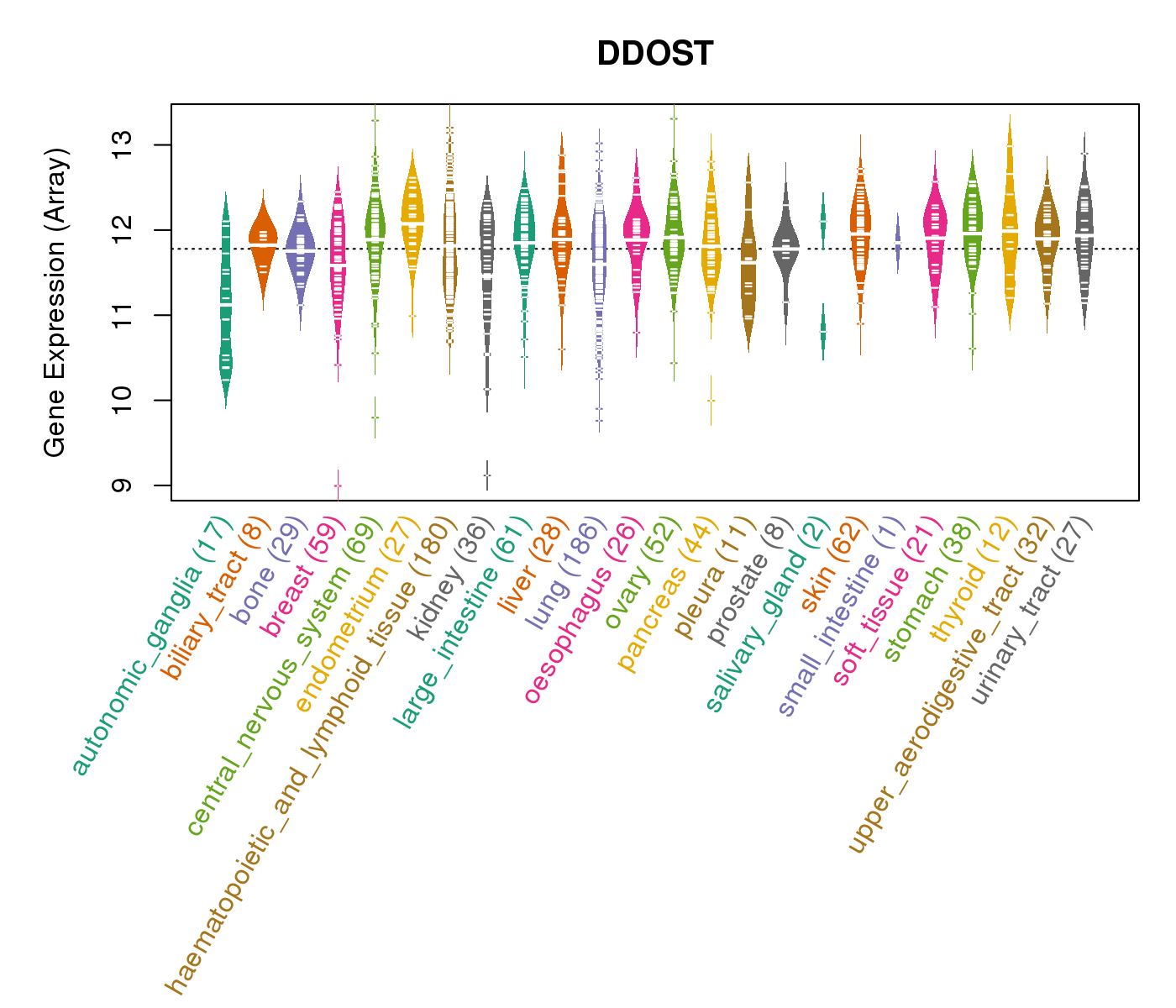 |
| * Normalized gene expression data of RNASeqV2 was extracted from TCGA using R package TCGA-Assembler. The URLs of all public data files on TCGA DCC data server were gathered at Jan-05-2015. Only eight cancer types have enough normal control samples for differential expression analysis. (t test, adjusted p<0.05 (using Benjamini-Hochberg FDR)) |
 |
| Top |
| * This plots show the correlation between CNV and gene expression. |
: Open all plots for all cancer types
 |
|
 |
|
| Top |
| Gene-Gene Network Information |
| * Co-Expression network figures were drawn using R package igraph. Only the top 20 genes with the highest correlations were shown. Red circle: input gene, orange circle: cell metabolism gene, sky circle: other gene |
: Open all plots for all cancer types
 |
|
| PITHD1,SZRD1,CALR,DDOST,DNAJB11,ENO1,KDM1A, EMC1,KIAA2013,LYPLA2,MRTO4,P4HB,PDIA4,PDIA5, PDIA6,PLOD1,PPIB,RCC2,RPN1,SEC61A1,SRM | AP1S1,APH1A,C11orf49,CAPN1,DDOST,EBNA1BP2,ERGIC3, GMDS,H2AFY2,MBOAT7,NIPSNAP1,NPM3,PAFAH1B3,PRPF19, RFC2,RNASEH2A,RUVBL1,SCAMP4,SLC35B2,STAP2,TMED3 |
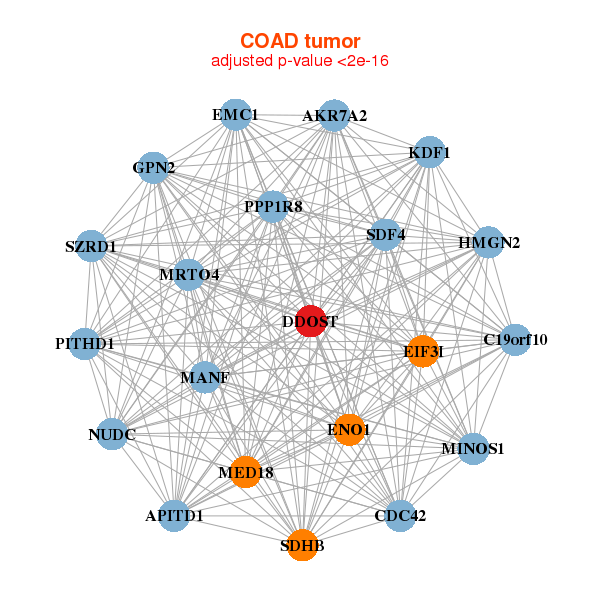 |
|
| AKR7A2,APITD1,C19orf10,PITHD1,SZRD1,MINOS1,KDF1, CDC42,DDOST,EIF3I,ENO1,GPN2,HMGN2,EMC1, MANF,MED18,MRTO4,NUDC,PPP1R8,SDF4,SDHB | APRT,BID,C19orf10,COPZ1,DDOST,ILF2,MTHFD2, NPM3,NUDT5,NUF2,NUP37,PCNA,PDIA6,PPIB, PRDX4,PYCR1,SNRPD3,SYNGR2,TMED3,TMED9,ZDHHC16 |
| * Co-Expression network figures were drawn using R package igraph. Only the top 20 genes with the highest correlations were shown. Red circle: input gene, orange circle: cell metabolism gene, sky circle: other gene |
: Open all plots for all cancer types
| Top |
: Open all interacting genes' information including KEGG pathway for all interacting genes from DAVID
| Top |
| Pharmacological Information for DDOST |
| There's no related Drug. |
| Top |
| Cross referenced IDs for DDOST |
| * We obtained these cross-references from Uniprot database. It covers 150 different DBs, 18 categories. http://www.uniprot.org/help/cross_references_section |
: Open all cross reference information
|
Copyright © 2016-Present - The Univsersity of Texas Health Science Center at Houston @ |









